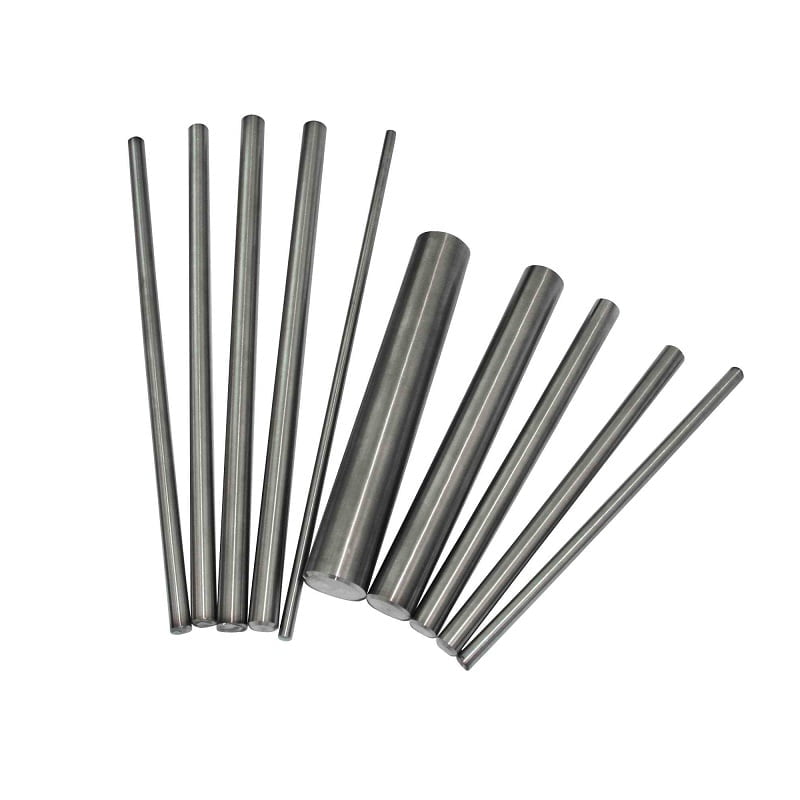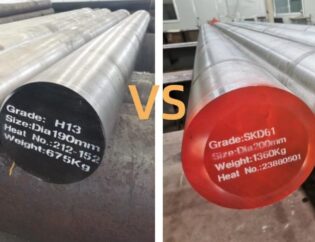
강철은 강도, 내구성 및 적응성으로 인해 엔지니어링 및 제조 응용 분야에서 가장 다재다능하고 널리 사용되는 재료 중 하나입니다. 이용 가능한 수많은 등급 중 12L14 그리고 1045 다른 요구에 부응하는 두 가지 주목할만한 유형입니다. 이 문서는이 두 강을 포괄적으로 비교하여 화학 조성, 기계적 특성, 응용 분야, 열 처리 능력, 용접 성, 비용 등을 탐구합니다.
12L14 스틸 개요
12L14는 주로 납과 황을 포함한 특정 합금 요소로 인해 뛰어난 가공성으로 알려진 저탄소 강철입니다. 등급은 일반적으로 정밀 가공이 필수적인 응용 분야에서 사용되므로 엔지니어와 기계공 중에서 가장 좋아합니다.
12L14의 화학적 조성
12L14 강의 화학적 조성은 가공 중에 특성과 행동을 이해하는 데 중요합니다. 일반적인 구성은 다음과 같습니다.
| 요소 | 구성 (%) |
|---|---|
| 탄소(C) | ~ 0.12% |
| 망간(Mn) | ~ 0.60% |
| 인(P) | ~ 0.04% |
| 유황(S) | ~ 0.26% |
| 납(Pb) | ~ 0.15% |
LEAD의 존재는 칩 형성을 개선하고 공구 마모를 줄임으로써 가공 보조제 역할을합니다.
12L14의 기계적 특성
12L14 스틸의 기계적 특성은 다양한 응용 분야에 적합합니다. 몇 가지 주요 속성은 다음과 같습니다.
| 재산 | 값 |
|---|---|
| 인장 강도 | 58,000 - 75,000 psi |
| 항복 강도 | 약 38,000 psi |
| 경도 | 약 85 HRB |
| 가공성 | 훌륭한 |
저탄소 함량은 많은 스트레스가 적은 응용 분야에 충분한 강도를 제공하면서 쉽게 가공 할 수 있습니다.
12L14 스틸의 응용
가공성으로 인해 12L14는 일반적으로 높은 정밀도가 필요한 응용 분야에서 사용됩니다. 일부 일반적인 응용 프로그램에는 다음이 포함됩니다.
| 응용 프로그램 유형 | 설명 |
|---|---|
| 정밀 가공 부품 | 샤프트 및 피팅과 같은 긴밀한 공차가 필요한 구성 요소에 사용됩니다. |
| 패스너 | 비용 효율성과 가공 용이성으로 인해 볼트, 나사 및 유사한 패스너에 사용됩니다. |
| 기어 | 다양한 기계의 저로드 기어에 일반적으로 사용됩니다. |
| 유압 부품 | 일관된 공차가 필요한 유압 피팅에 이상적입니다. |
1045 강철 개요
1045는 12L14에 비해 더 높은 강도와 경도를 제공하는 중간 탄소강입니다. 이 강철 등급은 일반 목적 응용에 적합하며 특성을 더욱 향상시키는 열처리 공정의 혜택입니다.
1045의 화학적 조성
1045 강의 화학적 조성은 더 높은 강도와 경도를 달성하는 데 더 집중하고 있습니다. 구성에는 일반적으로 다음이 포함됩니다.
| 요소 | 구성 (%) |
|---|---|
| 탄소(C) | ~0.45% |
| 망간(Mn) | 0.60 - 0.90% |
| 인(P) | ≤0.04% |
| 유황(S) | ≤0.05% |
탄소 함량이 높을수록 재료의 경도와 인장 강도가 크게 증가합니다.
1045의 기계적 특성
1045 스틸의 기계적 특성은 다음과 같습니다.
| 재산 | 값 |
|---|---|
| 인장 강도 | 85,000 - 100,000 psi |
| 항복 강도 | 약 65,000 psi |
| 경도 | 약 90 HRB 이상 |
| 가공성 | 보통의 |
탄소와 망간이 증가함에 따라 1045는 12L14보다 스트레스를 받고 내마모성이 향상된 성능을 나타냅니다.
1045 스틸의 응용
1045 스틸은 바람직한 기계적 특성으로 인해 다양한 응용 분야에 적합합니다. 일반적인 응용 프로그램에는 다음이 포함됩니다.
| 응용 프로그램 유형 | 설명 |
|---|---|
| 샤프트 | 힘과 비틀림 저항이 필요한 전력 변속기 샤프트에 사용됩니다. |
| 기어 | 고 토크 기어에 효과적이며, 종종 내구성 증가를 위해 열처리가 발생합니다. |
| 크랭크 샤프트 | 강도와 인성이 중요한 자동차 응용 프로그램에서 일반적으로 사용됩니다. |
| 무거운 의무 패스너 | 높은 인장 강도를 요구하는 응용에 이상적입니다. |
가공성 비교
가공성은 12L14와 1045 강철 사이의 선택에 종종 영향을 미치는 중요한 요소입니다.
| 특징 | 12L14 강철 | 1045 스틸 |
|---|---|---|
| 가공의 용이성 | 리드 컨텐츠로 인해 우수합니다. 더 빠른 절단 속도와 도구 마모 감소를 허용합니다. | 보통의; 특히 열처리 조건에서 가공은 어려울 수 있습니다. 더 선명한 도구와 정확한 기술이 필요합니다. |
12L14에 추가 된 리드는 더 부드러운 컷 표면을 생성하고 도구 수명을 연장하는 데 도움이되는 반면, 1045는 가공 중에 더 많은주의를 기울여야합니다.
열 처리 능력
열처리 공정은 12L14 및 1045 둘 모두가 원하는 기계적 특성을 달성 할 수있게한다; 그러나 그들의 열처리 응답은 크게 다릅니다.
| 특징 | 12L14 강철 | 1045 스틸 |
|---|---|---|
| 열처리 | 일반적으로 열처리되지 않습니다. 스트레스가 적은 응용 프로그램에 충분한 롤 조건에 사용됩니다. | 경도와 인장 강도를 크게 향상시키기 위해 담금질 및 템퍼링과 같은 열처리를 겪을 수 있습니다. |
1045의 열처리 능력은 애플리케이션을 요구하는 데 대한 다양한 선택이되는 반면 12L14는 특성을 원래 상태로 유지합니다.
용접성
용접 성은이 두 재료 중에서 선택할 때 고려해야 할 또 다른 중요한 요소입니다.
| 특징 | 12L14 강철 | 1045 스틸 |
|---|---|---|
| 용접특성 | 리드 함량으로 인해 용접에 권장되지 않으므로 용접 무결성이 나빠질 수 있습니다. | 주의해서 용접 될 수 있습니다. 중간 탄소 함량으로 인해 균열을 피하기 위해 예열이 필요할 수 있습니다. 적합한 필러 재료는 강한 용접에 필수적입니다. |
12L14의 용접성 부족은 종종 용접을 피하기 위해 설계 변경이 필요합니다.
비용 및 가용성
비용과 가용성은 종종 재료 선택에 중요한 역할을합니다.
| 특징 | 12L14 강철 | 1045 스틸 |
|---|---|---|
| 비용 | 일반적으로 합금 요소로 인해 일반 저탄소 강보다 비싸지 만 가공 효율로 인해 절약 할 수 있습니다. | 일반적으로 저렴하고 널리 사용 가능합니다. 다재다능한 특성으로 인해 다양한 응용 프로그램에 대한 인기있는 선택입니다. |
1045의 여러 형태 (바, 플레이트, 시트)의 가용성은 종종 대규모 응용 프로그램을위한보다 경제적 인 선택입니다.
요약 및 결론
결론적으로, 12L14와 1045 강철 사이의 선택은 궁극적으로 특정 프로젝트 요구 사항에 따라 다릅니다.
| 특징 | 12L14 강철 | 1045 스틸 |
|---|---|---|
| 기본 속성 | 우수한 가공성, 저탄소 함량 | 더 높은 강도, 열처리의 다양성 |
| 화학적 구성 요소 | 저탄소; 리드는 가공을 향상시킵니다 | Medium carbon; enhances hardness & strength |
| 기계적 성질 | 중간 정도의 인장 및 항복 강도 | 더 높은 인장 강도와 경도 |
| 애플리케이션 | 정밀 부품, 패스너, 유압 부품 | 샤프트, 기어, 자동차 부품 |
| 가공성 | 리드 컨텐츠로 인해 우수합니다 | 적절한 툴링을 사용하면 보통, 더 좋습니다 |
| 열처리 | 일반적으로 열처리되지 않습니다 | 개선 된 특성을 위해 열처리 가능 |
| 용접성 | 용접에 적합하지 않습니다 | 적절한 기술로 용접 할 수 있습니다 |
| 비용 및 가용성 | 더 높은 비용, 특수 가공 재료 | 더 경제적이며 널리 사용 가능합니다 |
이 두 강철 등급의 차이점을 이해함으로써 제조업체는 프로젝트 사양 및 성능 요구 사항에 맞는 정보에 근거한 결정을 내릴 수 있습니다. 12L14 및 1045 강철과 관련하여 더 구체적인 주제 나 추가 설명이 필요한 경우 자유롭게 물어보십시오!

